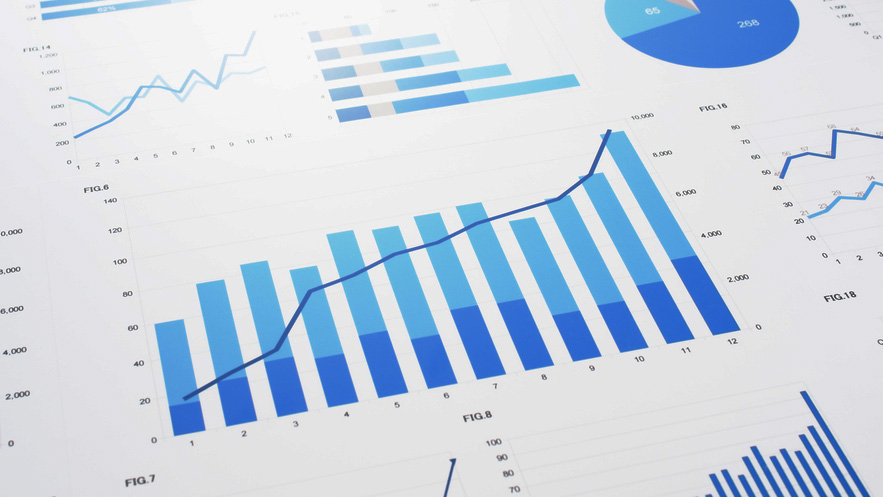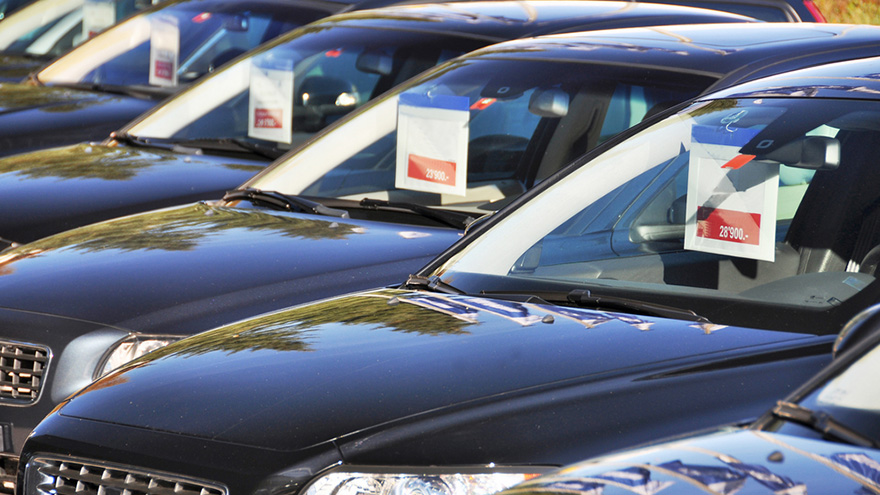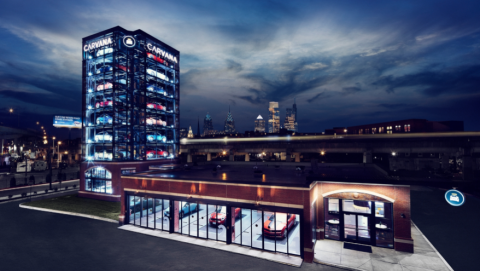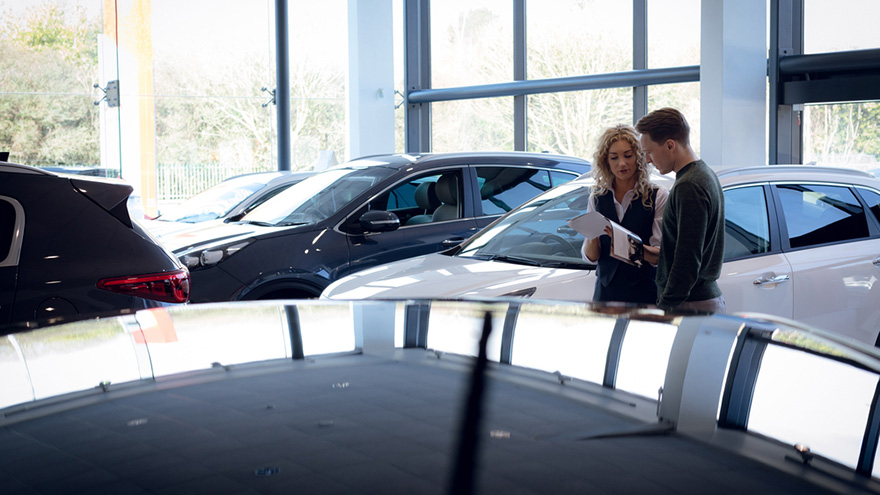The auto industry hit some bumps in the road during 2020, but there were some bright spots, including some positives in pre-owned.
Those were evident in earnings releases as the public dealer groups began reporting full-year results this week.
For instance, Lithia Motors increased its used-vehicle retail revenue by 13.4% in 2020, and sold 7.5% more used retail units. The group also was making 12.8% more gross profit per unit on used retail sales.
Elsewhere, Asbury Automotive Group, which did see retail used sales and revenue decline, generated 20% stronger average gross profit per unit on used retail sales, with used retail gross margins climbing 60 basis points. Used retail gross profits were up 9% year-over-year for the dealership group.
Below is a rundown on the two public retailers reporting annual and quarterly results, thus far, starting with Asbury.
Asbury retailed 80,537 used vehicles in 2020, compared to 88,602 in 2019.
Used retail revenue was at $1.93 billion for the year, down from $1.94 billion a year earlier.
Used retail gross profits at Asbury came in at $145.3 million, up from $133.1 million for full-year 2019.
Average gross profit per used vehicle retailed climbed from $1,502 to $1,804, while used retail gross margins climbed from 6.9% to 7.5%.
In the fourth quarter, Asbury retailed 21,386 used vehicles, down from 22,272 retail used sales a year earlier.
It had used retail revenue of $564 million, up from $491.5 million in Q4 2019. Asbury pulled in used retail gross profits of $39.2 million for the quarter, up from $30.9 million a year earlier.
Average gross profit per unit for used retail was $1,833 in Q4, up from $1,387 in the same period of 2019. Used retail gross margins climbed from 6.3% to 7.0%.
At Lithia, used retail revenue for the fourth quarter was $1.11 billion, up from $894.7 million in Q4 2019.
For the year, Lithia pulled in just under $4 billion in used revenue, up from $3.53 billion for full-year 2019.
Used-vehicle retail gross margins for Lithia were at 10.2% in Q4, up from 10.1% a year earlier. For the full year, they were at 11.2%, up from 10.4% in 2019.
Lithia sold 47,731 used retail units in the fourth quarter, up from 42,740 in Q4 2019. For the year, used retail sales climbed from 170,423 to 183,230 in 2020.
Gross profit per retail used unit was $2,369 in the fourth quarter, up from $2,109 in the prior-year period. For the full year, it was $2,432, up from $2,157.
Lithia Motors generated double-digit gains in same-store used-vehicle retail sales during both the fourth quarter and all of 2019 at 17% and 14%, respectively.
Dealer group management is eyeing even more growth this year and not just through what top Lithia executives called the “easy entrance point” of the used-vehicle space. Bottom line: Lithia wants each of its rooftops to turn 100 vehicles monthly, which would represent an 18% increase over its previous target of 85 units.
During the fourth quarter, Lithia stores turned 77 units per month on their way to 42,740 retailed used vehicles. The dealer group turned 170,423 used vehicles in 2019, up from 151,234 units a year earlier.
“Our experienced used-car managers remain focused on leveraging innovation to expand procurement of more used vehicles, which is the primary path to improving volumes,” Lithia executive vice president and chief operating officer Chris Holzshu said during the company’s fourth-quarter conference call.
“In addition, we’re looking closely at the 50,000 used vehicles we wholesale annually to ensure we capitalize on every opportunity we have to retail those vehicles,” Holzshu continued.
“Given the confidence we are gaining in the digital solutions that enable us to buy and sell more used vehicles, we have increased our target to sell at least 100 used units per location per month,” he went on to say while mentioning later in the call that some Lithia stores already are surpassing that goal.
Along with leveraging its wholesale strategy and relationships with more than 200 auto finance companies, Lithia highlighted that each segment of its used business produced gains in 2019. The company said sales in its value auto segment rose 12% while its core used vehicles climbed 21%. Lithia added that its certified pre-owned sales moved 8% higher.
It’s in that value segment — older, high-mileage vehicles that often are trades — where Lithia believes it can generate the most activity to reach its sales target. Lithia president and chief executive officer Bryan DeBoer explained.
“Getting into scarcer vehicles has lots of risk and without massive expertise in reconditioning, in sales, in guarantees and promises to our consumer. It’s not something that most people want to get into, because it’s messier. It also requires deeper financing sources, more specific and more unique financing sources,” DeBoer said.
“What you’re starting to see is the new entrants are pretty good at the 1- to 5-year-old vehicles, which is something that is attractive and there’s a plentiful supply of vehicles. And many of those (vehicles) don’t necessarily come from a new-car dealership. It comes after new-car dealerships decide they don’t want the car and they’re able to buy those cars at auction.
“So it’s the easy entrance point, whereas we believe that the profitability in both reconditioning, as well as in having people enter the Lithia family earlier, comes from those lower price vehicles,” DeBoer went on to say. “And our people are excellent at being able to recondition those vehicles and find those vehicles.”
“We’re more aggressive in terms of procurement of those vehicles,” he added. We believe that core and value are part of the promise of Lithia Motors gives to our customers when they’re at a new-car store. There are tendencies that consumers believe that they can’t buy cars that are a value or within their price range. What we provide is this is a great experience for them to be able to buy at a professional facility and be serviced in a professional manner.”
When asked again about retailing older used vehicles when late models are plentiful, Holzshu elaborated about why Lithia is leveraging this strategy to strive toward 100 retail sales per rooftop.
“As Bryan mentioned, there’s a lot of work that goes with it where our used car managers have to in some ways roll up their sleeves, get out and buy vehicles,” Holzshu said. “Right now, only a third of the used cars in the U.S. are sold through new-car dealers, and there’s no reason that number shouldn’t be much higher.
“Our whole focus right now is just to educate our stores on what the opportunity is, make sure that they have the resources, the capital, the expertise, the technicians, the reconditioning to be able to get those vehicles through the shops on the front lines and get them financed,” Holzshu continued. “There’s a lot of pieces that go into that, but it’s really about the people and the talent.”
Also of note from its latest financial statement, Lithia shared how several other portions of its business performed well as the company set a new record for quarterly revenue at $3.3 billion and for the full year at $12.7 billion.
Lithia reported used-vehicle gross profit per unit finished this year at $2,157 while F&I gross per unit came in at $1,478.
The group pointed out service, body and parts same-store sales increased 7% year-over-year.
“Our stores and their phenomenal teams continue to be focused on creating convenient and transparent consumer experiences to generate our strong results,” DeBoer said.
And soon after releasing its financials, Lithia acquired a pair of Lexus stores in California.
“With over $1 billion in liquidity through our cash, availability on our credit facility, and unfinanced real estate, we remain well positioned to take advantage of the robust acquisition market in 2020,” DeBoer said.
A new study has found that customer service representatives, especially at tire-focused retailers, fail to book appointments or sell products one out of three times. That was the case even after callers on the phone expressed that they wanted to buy or that they wanted to book an appointment.
The study from conversational analytics company Marchex analyzed 8.7 million inbound calls to aftermarket auto services centers across the United States and found that 13% of all calls to stores result in no connection at all. That is because of hold time or “voicemail abandons,” the study showed.
Or, the failed connection occurred simply because the business did not answer the phone.
“The data shines a spotlight on how auto services stores, particularly those that offer tires, can boost sales just by understanding how to speak to customers at each touchpoint in the journey,” Marchex head of automotive Matt Muilenburg said in a news release.
He continued, “Not picking up the phone or saying ‘no’ too often is simply bad for business.”
The report states that those phone call failures equate to a multi-million-dollar opportunity for brands that can create better customer experiences over the phone.
So how can stores improve call handling and drive more revenue? The report provides three steps:
— Quantity: Fix inefficient processes by taking steps such as answering calls at peak times, avoiding putting callers on hold, and avoid sending callers to voicemail.
— Quality: Make sure every interaction offers a positive experience for the caller. Know your inventory and be ready to offer alternatives with appointments or products.
— Conversation: Request the caller’s name and use it, and ask plenty of questions.
According to the report, the trend of people keeping their cars longer or turning to the used-vehicle market to meet their needs means that “aftermarket retailers and service providers should be bullish.”
Marchex Institute analysts reviewed conversation data across 11 major aftermarket brands. They found that 54% of all calls to auto services stores are from consumers who want specifically to make an appointment or buy a product.
According to the report, stores leave an average of $108,000 of revenue per location on the table each year due to poor call handling.
To generate revenue and improve the customer experience, an understanding of how stores handle these calls from prospective customers is important, according to the study.
The data also showed that 68% of callers who don't reach a business on first attempt don't call back.
“Competition in the industry is fierce, and prospective customers are quick to move on if they don’t get what they want on their first try,” Marchex wrote.
In more than 30% of calls that ended in what the study describes as negative outcomes, customers were calling about tires. Marchex calls tires one of the highest-value opportunities in the aftermarket industry.
Customers heard the word, “no” in those calls often when appointment times weren’t available or inventory was out of stock.
“The data shows there is potentially millions of dollars up for grabs in a growing industry by optimizing phone calls,” Muilenburg said.
He continued, “Calls are a critical step in the path to purchase for the consumer. Yet stores miss out every month on opportunities to generate revenue and capture new customers because of their poor call handling processes.”
Based on sales data for the first six months of each calendar year dating back to 2013, franchised dealerships are retailing more used vehicles this year than ever.
The National Automobile Dealers Association shared that sales trend on Wednesday afternoon as a part of its midyear version of NADA Data 2019, a biannual financial profile of America’s franchised dealerships highlighting major milestones in the retail automotive industry.
The report indicated franchised dealers retailed 7.89 million units during the first six months of this year. That’s up from 7.55 million used sales during the first half of 2018.
The used-vehicle sales pace franchised dealers currently are traveling is much higher than what NADA recorded earlier this decade. Here is the rundown of sales figures at the year’s midpoint:
2019: 7.89 million
2018: 7.55 million
2017: 6.91 million
2016: 7.00 million
2015: 6.76 million
2014: 6.71 million
2013: 6.65 million
The report — that’s available for download here — also showed the average retail price of those used vehicles being turned at franchised stores is on the rise, too. Halfway through 2019, that average retail price stood at $20,835.
Here is the rundown of those readings:
2019: $20,835
2018: $20,390
2017: $19,970
2016: $19,880
2015: $19,240
2014: $18,700
2013: $17,930
Used-car sales in April beat year-ago figures by 3.0%, according to estimates from Cox Automotive, which said the pre-owned SAAR climbed to about 39.3 million for the month.
That compares to a used-car SAAR of 38.1 million in April 2018 and a 39.0 million used-car SAAR in March, the company said in its Manheim Used Vehicle Value Index Data & Commentary released Tuesday.
In a separate forecast released late last month, Edmunds was calling for 3.4 million used-car sales in April, down from 3.7 million in March. The resulting used-car SAAR was projected at 39.1 million, compared to 39.2 million in March.
Going back to the Cox Automotive data, such pre-owned strength observed in April continues what the company described in Monday’s Data Point report as a “shift in vehicle demand, away from new and toward used.”
New-vehicle sales, which fell 1.7% year-over-year in April and had a SAAR of 16.4 million, compared to 17.4 million in March and 17.2 million a year ago, had dipped 2% percent in the first quarter, according to the two reports from Cox Automotive.
“The used-vehicle market, on the other hand, continues to see favorable performance. Affordability concerns driven by higher vehicle prices and interest rates have reduced the pool of people who can afford to buy new,” Cox analysts said in Data Point.
“With attractive off-lease supply available, the used-vehicle market is benefiting from robust demand,” they said. “In fact, supply is more of a concern in the used- vehicle market than demand.”
And that’s quite a statement given the amount of supply in the used-car market, which appears to be peaking.
Publics embody shift toward used
The first-quarter performances of the six publicly traded dealer groups are emblematic of the demand “shift” described above, Cox Automotive said in Data Point.
Their same-store used-vehicle unit sales were up a combined 4% year-over-year in Q1, according to the six companies earnings filings cited by Cox Automotive. Their combined same-store new-vehicle units were down nearly 9%.
“Looking at Q1 performance of these publicly traded dealer groups’, which accounted for roughly 6% of new vehicle sales in the U.S., the trend in our industry is crystal clear: New sales are down, used sales are up,” Cox Automotive said in Data Point. “Consistent in their filings was recognition that the used-car business was one of the few bright spots in an otherwise difficult quarter.”
That said, how long that continues is unclear. Such strength is heavily reliant on used-car supply, which may be reaching a tipping point.
“How much they can skew to used-vehicle sales will be contingent on used-vehicle supply,” Cox Automotive went on to say. “And it will only get more difficult going forward, as the largest driver of high-demand, high-profit supply — off-lease units — are at their peak this year.”
There were 4.3 million leases written back in the record year of 2016, according to an Edmunds forecast released late last year, and those cars are now making up the off-lease volume in 2019. But as the Edmunds data shows, leasing leveled off a bit, with 4.2 million units leased in both 2017 and 2018.
And in a related analysis released last month, Cox Automotive said the “total volume of wholesale requiring disposal” will reach a peak this year.
Specifically, 16.6 million units are projected to be wholesaled, up from 16.4 million units last year, 15.9 million units in 2017 and 15.5 million units in 2016, the company said.
In challenging times, used-vehicle sales are there to take up the slack.
At least that was the case for Group 1 Automotive in the fourth quarter and full-year 2018.
When times are good for auto dealers, used-vehicle sales also often play a prominent role, and that was the case for Asbury Automotive Group, too, as used vehicles helped that company achieve a record-breaking sales year in 2018.
For Group 1, its 2018 revenue of $11.6 billion was an all-time record for the company. Group 1 retailed more than 170,000 new and approximately 150,000 used vehicles.
But for fourth-quarter 2018, Group 1’s U.S. comparisons to fourth-quarter 2017 faced some challenges, in part because of the company’s accelerated 2017 sales in its Houston and Beaumont, Texas markets after Hurricane Harvey. New-vehicle sales for those areas were down in the third and fourth quarters of 2018.
For the full year of 2018, however, used-vehicle sales helped save the day for Group 1.
“Despite these difficult comps, our U.S. operations team delivered positive full-year, same-store gross profit growth through a continued focus on improving our used-vehicle and aftersales business as well as a record-setting year in F&I,” Earl Hesterberg, Group 1 president and chief executive officer, said during the company’s 2018 fourth quarter and full-year financial results conference call on Feb. 5.
Retail used-vehicle gross profit increased 4.7 percent on a revenue increase of 13.1 percent. The company retailed 147,999 used vehicles in 2018, a 13.9 percent increase over 2017.
Used vehicles help Group 1 ease new-vehicle challenges
Hesterberg did not provide an update on the specific measures Group 1 is taking to improve its used-vehicle business, but last year the company launched Val-U-Line, a proprietary brand for older-model, high-mileage, pre-owned vehicles. The company notes that Val-U-Line targets a growing customer demand and allows Group 1 to retail lower-cost units that would have otherwise been sent to auction.
In the conference call, Hesterberg mentioned the used business as helpful in offsetting new-vehicle challenges. He started by discussing the new-vehicle business, noting that total consolidated new-vehicle revenues in the fourth quarter decreased 4 percent on a constant currency basis, driven by a 6-percent decrease in unit sales related to Hurricane Harvey comps and U.K. emissions legislation.
Moving on to discuss the used-vehicle business, Hesterberg said the company retailed more than 36,000 used units in the fourth quarter of 2018, with the United States and United Kingdom performing well. Total consolidated used-vehicle revenues grew 8 percent on a constant currency basis, and the company sold 6 percent more units with a 2-percent increase in the average used-vehicle selling price. Total used-vehicle gross profit increased 9 percent on a constant currency basis.
“The used volume and per-unit margin increase were the result of our corporatewide focus in this area of our business and especially our Val-U-Line initiative in the U.S.,” Hesterberg said.
He added that on a year-over-year same-store basis, he was proud to see continued strong growth in used retail unit sales, with an 11-percent gain in the fourth quarter. He noted that the Val-U-Line retail unit sales generated more than 10 percent of the company’s used volume during the quarter.
Responding to a conference call participant who asked for more information on the benefits of Val-U-Line, Daryl Kenningham, Group 1 president, U.S. operations, said the company feels Val-U-Line’s 10 percent of quarterly used volume is a good level at this point.
“We’re always watching to make sure it’s incremental,” Kenningham said. “It is not substitutional. That’s a continual focus for us.”
The numbers consistently showed used vehicles helping to save the day for Group 1. Retail used-vehicle revenues increased 8.8 percent (10 percent year-over-year comparable basis) in the fourth quarter on 12.8 percent higher unit sales. Retail used-vehicle gross profit increased 1.4 percent (2.4 percent year-over-year comparable basis) to $41.1 million.
Used vehicles’ strong role in Asbury’s record year
Asbury Automotive’s record year in 2018 included generation of $6.9 billion of revenue, as well as retailing of more than 185,000 vehicles and servicing of more than 2 million vehicles.
“Our success was driven by growth in our used-vehicle business, higher F&I gross profit and continued solid growth in parts and service,” David Hult, Asbury president and chief executive officer, said in the company’s fourth quarter 2018 earnings conference call on Feb. 6.
Asbury increased its used-to-new ratio by 160 basis points, resulting in used-vehicle unit sales increasing by 5 percent and a 7-percent increase in used-vehicle gross profit, said John Hartman, Asbury’s senior vice president of operations.
He added that the company’s deployment of omni-channel initiatives along with Asbury’s used-car enterprise software, contributed to some of the strong results. Hartman noted that the company’s used-vehicle inventory of $159 million was at a 34-day supply which is within its targeted range of 30 to 35 days. He added that increased volume sales led to an F&I gross profit increase of 3 percent.
“The improved used-vehicle sales drove reconditioning work within parts and service to increase by 5 percent,” Hartman said.
A more detailed look at the sales numbers provides additional evidence of how used vehicles came to the rescue for Asbury. For all stores, Asbury’s new-vehicle revenue increased 6 percent in the fourth quarter, with new-vehicle gross profit decreasing 6 percent.
But used-vehicle retail revenue and used-vehicle gross profit both increased by 10 percent in the quarter, as well. Finance and insurance revenue and gross profit increased by 6 percent. On a same-store basis, new-vehicle gross profit decreased 7 percent. However, used-vehicle gross profit on a same-store basis increased 7 percent, and used-vehicle retail revenue also increased 7 percent.
More on used vehicles helping Group 1 results
But although used vehicles played a key role in Asbury’s record sales year, their role in helping Group 1 through its challenges was key. The Worldwide Harmonised Light Vehicle Test Procedure legislation, which caused new-vehicle supply shortages in the U.K., was another challenge.
“Our strong performance in used vehicles, parts and service, and F&I allowed us to deliver positive same-store gross profit growth despite these very significant headwinds in our new-vehicle business,” Hesterberg said.
This past Saturday included beautiful weather here in central North Carolina — bright sunshine, a slight breeze and clouds like they had been painted for a baby’s room. It was the kind of Saturday dealership general managers often hope lead to active showrooms, busy finance directors and vehicles rolling over the curb at a nice clip.
As I departed home a little before lunchtime, oncoming traffic continued to illustrate how Saturdays illuminated by beautiful weather can be wonderful for the car business. However, an individual in my neighborhood who took delivery never went to a dealership. You see, the truck I passed was a Carvana flatbed carrying a late-model Honda Civic in glistening silver.
That particular Carvana turn arrived following a year in which the company reported that it retailed 94,108 used vehicles in 2018, representing an increase of 113 percent year-over-year.
Carvana also shared last Wednesday that 2018 revenue came in at $1.96 billion, marking an increase of 128 percent year-over-year. The company watched its total gross profit spike 189 percent year-over-year to $196.7 million as gross per unit rose $594 to $2,133.
While I didn’t connect with the individual who now is driving that Honda Civic, about a year ago I struck up a conversation with another neighbor who made a vehicle purchase via Carvana. (Coincidently, it also was a Civic.) Being an observer of wholesale, retail and finance activities here for Cherokee Media Group, I asked the individual how the experience was securing a vehicle through Carvana.
That individual has well-paying employment in the technology field but has a thin credit file, so obtaining financing was difficult. But the individual noted the process with Carvana was simple and the family of four gained reliable transportation.
Later on this beautiful Saturday, I noticed other vehicles with indications of recent delivery. They had dealership decals from both franchised and independent stores. I also noticed a few other vehicles with those blue Carvana license plate brackets. (They mix in nicely in this area with individuals who have a similar item on their vehicles in support of the University of North Carolina that has a similar color scheme.)
In its 29-page letter to shareholders, Carvana chairman and chief executive officer Ernie Garcia and chief financial officer Mark Jenkins shared more company superlatives.
Carvana now operates in 72 markets, adding 41 more locales last year. If customers want an even more unique experience instead of just having a flatbed roll up with their purchase, Carvana now has 15 of those vending machines described eloquently here by my colleague Joe Overby.
Garcia and Jenkins pointed out that Carvana’s gross per unit is now more than $1,000 higher now than it was two years ago.
And we also shared through our Cherokee Media Group reports, Carvana has a significant relationship with Ally Financial and now its vehicles also are included within the Bank of America shopping and financing platform.
“Four weeks ago, we celebrated the sixth anniversary of launching a whole new way to buy a car to customers in Atlanta,” Garcia and Jenkins wrote in the shareholder letter summary.
“In that time, we have accomplished a lot,” they continued. “We have progressed from an idea germinating in the minds of a few passionate people, to a product customers love, to an incredible business with even more incredible prospects. In that first year, we sold fewer than 250 cars including a blockbuster month in December where we chalked up 42 deliveries. Since then, we have grown at triple digit rates every single quarter.
“That growth is pretty profound and it comes from two powerful forces: our customers’ love for our product, and our people’s love for building and delivering it. Our team is energized, focused, and executing at the highest level in our history. If we do our jobs from here, those same two forces will drive us to our goal of selling 2 million units per year,” they went on to say.
No doubt, Carvana is going to need much more than sunny Saturdays to deliver 2 million units annually. Even CarMax — which operates 186 locations nationwide — retailed 721,512 units during its 2018 fiscal year, according to the company. That figure is up from 526,929 vehicles during its 2014 fiscal year.
However, Carvana seems well on its way toward achieving its ambitious objective, especially with how people like to make purchases nowadays along with scale and financial resources at its disposal. The company set ambitious goals for 2019, looking to be retailing in 145 markets and turning 160,000 vehicles by the end of this year.
“Our ability to execute at even greater scale continues to give us confidence in our path to selling 2 million cars per year,” Garcia reiterated in a company news release.
Should Carvana hit that target, it indeed would be a sunny day for the company.
Nick Zulovich is part of the team at Cherokee Media Group and senior editor of Auto Fin Journal, SubPrime Auto Finance News and BHPH Report. He can be reached at [email protected].
It was the eighth straight year of record certified pre-owned car sales, amid an overall used-car retail market that is still seeing some strength.
And while there are signs the used-car market may have peaked from a sales volume perspective, the feeling around last week’s NADA Show 2019 — and in recent forecasts and analyses — is that there’s a still a lot of opportunity in this segment.
Patrick Manzi, senior economist at the National Automobile Dealers Association, said during a press conference at the convention that franchised dealers had increased year-to-date used-car sales 5.1 percent through November.
“And we do expect that trend is going to continue,” Manzi said.
Franchised dealers sold 12.2 million used cars for full-year 2018, according to a presentation from Thomas King, the senior vice president of J.D. Power’s data and analytics division, during the J.D. Auto Summit held just before NADA.
That was up from 11.8 million in 2017 and continues what has been a simultaneous rise in franchised used-car sales and off-lease supply, according to J.D. Power data.
In 2014, there were 10.4 million used-car sales at franchised dealers amid off-lease volumes of 2.2 million units, the data indicates. Both numbers have steadily risen to 12.2 million used sales at franchised stores in 2018 and off-lease supply of 3.7 million.
King said to expect 4.1 million in off-lease units this year.
He said he is “encouraged by the fact while there are challenges to used-vehicle profitability, the overall performance on used is better than we see on new.”
In a presentation later that day, Jonathan Banks — who is vice president and vehicle valuations and analytics at J.D. Power — echoed much of King’s sentiment on used opportunities.
“When you think about (King’s) positive outlook for new-vehicle sales — some risk, but overall positive — we believe the used-vehicle segment has the same (outlook), maybe even a little more positive, especially from a dealer perspective,” Banks said. “From an opportunity perspective, we think the used market is really poised to offer huge opportunities that haven’t really been around and really are based on a fundamentally healthy market.”
Banks also noted that used-car gross margins faring better than new-car gross margins these days, and that the pre-owned market is attracting Generation Y and Generation Z buyers.
New-car sales and used-car sales are heading in different directions, he said.
“We’re in a new era, to me, of utilizing used-vehicle sales to offset that decline in new-vehicle sales, creating affordability, but in a whole different way. It’s affordability to a mindset,” Banks said. “Gen Z’s are looking to affordability, but it’s a mindset. It’s not like the affordability we went after post-recession … where you’re coming out of the economy collapsing.”
Along those lines, while NADA is seeing used-car payments climb, there is still a strong gap between those on the new-car side.
“I think a lot of consumers, when they walk into the dealership, they may have gone in expecting to get a new vehicle, but then they look over at the used lot and they see pretty much the same car, 2 or 3 years old, low miles and a big $150 gap,” Manzi said, referring to the gap in monthly payments.
“That’s going to be enough to pull a bunch of consumers over to the used market, even those with really good credit will be tempted by these used vehicles,” he said.
With what he described as a strong labor market, Manzi said younger generations are now going out to buy cars and most of those are going to turn to used.
Expectations for this year
It’s expected that January will see overall used retail sales — including those involving franchised dealers, independent dealers and private parties — reach 3.1 million units, according to Edmunds.
That would beat December’s total of 2.7 million, but represent a slower seasonally adjusted annualized rate of 39.2 million (against the 39.7 million SAAR last month), Edmunds said.
In its NADA Show press conference, Cox Automotive predicted full-year overall used-car retail sales of 39.5 million units for 2019, which would be consistent with last year’s figures.
“The used-vehicle market came in at the best year for the expansion at over 39.5 million units, thanks to favorable supply and demand, helping that part of the business grow,” Zohaib Rahim, Cox Automotive’s manager of economic and industry insights, said of 2018.
“However, looking forward, we are expecting a market that is post-peak,” Rahim said.
Cox Automotive is projecting 2020 used sales of 39.2 million, following this year’s 39.5 million.
Certified pre-owned still hot
One area of the used-car market that continues to bear fruit is CPO. Citing data from Autodata, KAR Auction Services chief economist Tom Kontos said certified sales in December climbed 8.4 percent from November and 1.3 percent from December 2017.
That led to a 2.1-percent hike in full-year CPO sales, Kontos said.
“On the demand side, CPO sales were strong in December and helped set another annual sales record,” Kontos said in the latest edition of his Kontos Kommentary.
Likewise, in this Kelley Blue Book post last week, KBB’s Matt DeLorenzo pointed out Cox Automotive economist estimates that there were 2.7 million certified sales last year, the eight straight all-time high.
More than a year later, Hurricane Harvey still is influencing how wholesale prices and used-vehicle sales are analyzed. The record-setting storm that blasted Texas created comparisons that might make metrics appear odd.
According to ADESA Analytical Services’ monthly analysis of wholesale used-vehicle prices by vehicle model class, wholesale used-vehicle prices in September averaged $10,981 — down 0.6 percent compared to August and 0.6 percent lower than September of last year.
KAR Auction Services chief economist Tom Kontos explained prices for the truck model class segments, on average, fell at a similar rate as car prices, supporting his theory that the two groups will tend to move in parity as truck supply outpaces car supply.
In his latest edition of the Kontos Kommentary, he explained how he and the company analyst team are entering the timeframe when Harvey-influenced figures will be involved, especially with their year-over-year examinations.
“As the wholesale used-vehicle market enters the period of time comparable with last year’s hurricane season, wholesale prices will be challenged to meet last year’s high, demand-driven levels,” Kontos said.
“This is reflected in average wholesale prices in September, which fell on both a month-over-month and year-over-year basis, and significantly lower retail used-vehicle sales than last year,” he continued.
“Prices for off-lease units remained strong, however, as upstream remarketing continues to deny volume from physical auctions and causes dealers unable or unwilling to participate in online-only auctions to bid aggressively on the remaining downstream units,” Kontos went on to say, elaborating further in this online video.
A regular part of Kontos’ updates also includes analysis of fleet/lease sales of 3-year-old units with mileage between 36,000 and 45,000 miles. When holding constant for sale type, model-year age, mileage, and model class segment, Kontos discovered prices were up significantly on a year-over-year basis for both midsize cars and midsize SUV/CUVs.
Prices for those midsize cars rose 6.0 percent or $699 to $12,298, while prices for those midsize SUV/CUVs climbed 4.6 percent or $901 to $20,634.
“Midsize car prices continue to outperform prices for midsize SUVs and crossovers, due, as mentioned above, to the incoming supply of trucks outpacing that of cars,” Kontos said.
“The strength of prices for both groups in this analysis indicates, again as mentioned above, that upstream sales are preventing an oversupply of off-lease units from reaching physical auction lots,” he added.
Looking at the September data for the entire market, Kontos shared that average wholesale prices for used vehicles remarketed by manufacturers softened 1.9 percent month-over-month but ticked up 0.7 percent year-over-year.
Kontos noted prices for fleet/lease consignors dipped 1.3 percent sequentially but rose 6.6 percent annually.
Furthermore, he added average prices in September for dealer consignors ticked 0.4 percent lower versus August and 0.3 percent relative to the same month last year.
Kontos closed his latest update by reviewing September sales information he received from the National Automobile Dealers Association and Autodata Corp.
Based on NADA data, Kontos said retail used-vehicle sales by franchised dealers slid 6.3 percent year-over-year in September, and deliveries dropped 8.7 percent for independent dealers.
Kontos also pointed out that September certified pre-owned sales declined 8.9 percent compared to the prior month and 3.9 percent year-over-year, according to figures from Autodata. On a year-to-date basis, he added CPO sales remain up 1.8 percent versus last year.
ADESA Wholesale Used-Vehicle Price Trends
| |
Average |
Price |
($/Unit) |
Latest |
Month Versus |
| |
Sept. 2018 |
Aug. 2018 |
Sept. 2017 |
Prior Month |
Prior Year |
| |
|
|
|
|
|
| Total All Vehicles |
$10,981 |
$11,048 |
$11,046 |
–0.6% |
–0.6% |
| |
|
|
|
|
|
| Total Cars |
$8,617 |
$8,692 |
$8,777 |
-0.9% |
-1.8% |
| Compact Car |
$6,533 |
$6,481 |
$6,681 |
0.8% |
-2.2% |
| Midsize Car |
$7,491 |
$7,590 |
$7,788 |
-1.3% |
-3.8% |
| Full-size Car |
$7,655 |
$7,510 |
$7,243 |
1.9% |
5.7% |
| Luxury Car |
$13,380 |
$13,615 |
$14,016 |
-1.7% |
-4.5% |
| Sporty Car |
$14,327 |
$14,367 |
$13,906 |
-0.3% |
3.0% |
| |
|
|
|
|
|
| Total Trucks |
$12,949 |
$13,040 |
$13,183 |
–0.7% |
-1.8% |
| Minivan |
$8,314 |
$8,222 |
$9,061 |
1.1% |
-8.2% |
| Full-size Van |
$13,365 |
$13,784 |
$13,165 |
-3.0% |
1.5% |
| Compact SUV/CUV |
$10,781 |
$10,765 |
$10,679 |
0.2% |
1.0% |
| Midsize SUV/CUV |
$11,144 |
$11,060 |
$11,424 |
0.8% |
-2.5% |
| Full-size SUV/CUV |
$13,941 |
$13,370 |
$13,742 |
4.3% |
1.5% |
| Luxury SUV/CUV |
$18,285 |
$18,491 |
$19,209 |
-1.1% |
-4.8% |
| Compact Pickup |
$9,981 |
$10,228 |
$9,591 |
-2.4% |
4.1% |
| Full-size Pickup |
$16,317 |
$16,638 |
$16,963 |
-1.9% |
-3.8% |
Source: ADESA Analytical Services. August data revised.
If you think the East Coast is hot right now, look at what’s happening in the used-car market. Especially in terms of prices.
One particular index measuring used-car prices is poised to reach its highest level in almost three years, the annual retail sales rate is approaching 40 million and dealers are showing optimism.
Granted, there could be some concern, specifically around supply.
Starting on the retail side, used-car sales this month are likely to remain steady with July’s figures, with the seasonally adjusted annualized rate actually seeing a nice bump.
That’s according to projections released Wednesday by Edmunds, which said the used-car retail market should once again reach 3.4 million sales for the month. The August used-car SAAR would then be 39.7 million, up from 39.5 million in July.
Following a consignor and wholesale event last week, Cox Automotive senior economist Charlie Chesbrough had this to say about the used-car market: “After talking to dealers at the 2018 IARA Summer Roundtable, it’s clear that the used-vehicle business is good right now.
“The market is looking strong for 2018, with dealers still optimistic for 2019 as well,” he said in emailed comments provided to Auto Remarketing.
“However, with concerns that affordability is changing, headwinds may be in sight down the road in 2019,” Chesbrough said. “Anticipation around tariff proposals and their impact on new and used vehicles have also resulted in some pull-ahead activity, as dealers try to position themselves for the future of the used-vehicle market.”
On the pricing side, August could end being the strongest month in three years for the Seasonally Adjusted Used Vehicle Price Index from J.D. Power Valuation Services.
In a blog post earlier this week, senior automotive analyst David Paris said August used-car prices have shown sequential gains through the first three weeks of the month. What’s more, they’re likely to be higher than first projected by month’s end.
Specifically, the current J.D. Power reading of 122.0 is 2.3 points higher than July’s, Paris said.
If this trend holds, August would represent the index’s highest mark since late 2015 and be the third straight monthly gain.
“The used-vehicle market really started showing its strength in the middle half of 2017, and there are no signs of it letting up. Most of the market’s lift in prices has been driven primarily by mainstream car growth, however, mainstream utility segments continue to show firmness as well,” Paris writes in the post.
“However, luxury car and SUV segments are not experiencing the same long-running positive trend as their mainstream counterparts due in part to higher incentive spend on the new side of the market,” he said.
“There are two primary factors behind why the used market continues to heat up: first dealers are placing more emphasis on used-vehicle operations, and second, vehicle affordability is becoming increasingly important to consumers.”
That’s not to say there are not some negative factors at play.
In fact, Chesbrough at Cox Automotive said one “glaring concern” is used-car supply, especially as the 10-year anniversary of the Great Recession looms.
And the concern is not about having too much; rather, it is about not having enough.
The tables, it would appear, have turned.
In his analysis, Chesbrough lists these as key impacts on used-car supply:
First, “During the heart of the recession (approximately 2008-2011) the industry lost out on millions of vehicle sales. This is coming back around and resulting in a big hole in supply today, requiring dealers to buy newer vehicles at much higher prices.”
Next, he said: “A strong economy has resulted in fewer repossessions.”
Lastly, “Residual values have been declining over the past couple of years,” Chesbrough said.
On the new-car side, supply is at its lowest point in two years, Edmunds said. Granted, this indicates some realignment of new-car inventory to better meet demand. However, Edmunds said, this is also indication of lower sales versus recent years.
“There are a lot of things working against the automotive market right now: Incentive spending is maxed out, interest rates are rising, and vehicle prices are reaching record highs,” said Jeremy Acevedo, manager of industry analysis at Edmunds, in a news release, referring to the new-car market.
“Add to that the uncertainty that comes with renegotiating NAFTA and tariff talks and it amounts to what could be a challenging back half of the year for automakers.”
In a data set going a bit further back, Experian shared some payment data for both new and used, pointing out that new- and used-vehicle monthly payments hit record highs during the second quarter, with the average new monthly payment increasing $20 year-over-year to $525, and the average used monthly payment increasing $13 over the same time period, reaching $378.
Taking an even closer look at the data, Experian explained that finance companies can gain insights from the gap between new and used financing payments, which continues to widen, reaching $147 in the second quarter.
“For some consumers, that gap can mean the difference between buying a new or used vehicle,” Experian said in its analysis.











